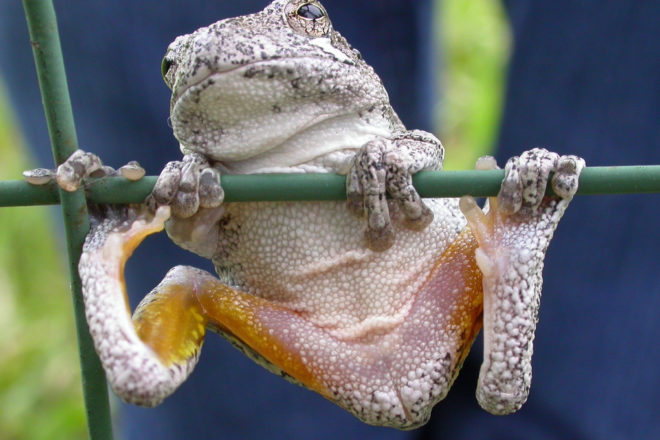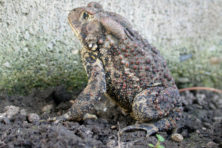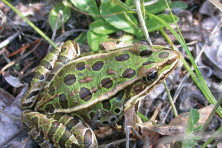Door to Nature: Frogs and Toads
- Share
- Tweet
- Pin
- Share

Late April is when my late husband, Roy, and I used to venture down a trail in The Ridges Sanctuary to listen for the croaking wood frogs in one of the swales. Their calls can be compared to raspy, quacking ducks, or, as Roy used to say, they sound like the old cartoon character Mr. Magoo.
Wood frogs are found from the southern Appalachians and much of the northeastern part of the continent, up to Alaska and north of the Arctic Circle. They live farther north than any other amphibian, and these amazing creatures can survive freezing temperatures for up to seven months by increasing their glucose levels to prevent death. The glucose acts like antifreeze in their system.
They range in size from one and a half to three inches, and they have a distinctive, black mask. Eggs – laid in vernal ponds and shallow freshwater pools – are attached to submerged vegetation. Once hatched into tadpoles in six to 12 weeks, wood frogs leave the water and remain on dry land until the following spring.
The leopard frog – also known as the meadow frog – is still fairly common in our area. At one time we thought they were decreasing at a rapid rate, but we often see a nice population in the late summer at Toft Point near the old homestead.
The leopard frog is easily identified by the numerous irregularly placed, rounded blotches on the body, which are encircled with white. This helps the observer to differentiate them from the similar pickerel frog. Colors range from green to brown and mixtures of both.
These two- to four-inch-long amphibians are found in most of the country. They inhabit fresh water, and their eggs take up to three months to develop into adult frogs. Studies have shown that leopard frogs have a definite home range and return to their home area, up to a point, when they wander away.
Leopard frogs winter in what is called a hibernaculum, usually at the bottom of a pond, stream or other body of quiet water, and often at least several feet deep. The frog does not bury itself in the mud during the winter, but instead, it simply lies torpid on the bottom in the water, often beneath the ice.
Door County is fortunate to have at least seven species of frogs and toads: the two aforementioned, plus the western chorus frog, eastern gray tree frog, northern spring peeper, eastern American toad and green frog. The last two may be rather sparse in this part of the state.
I remember hearing chorus frogs years ago in the middle of the county. They have such a distinctive sound, like running your fingernail down the teeth of a plastic comb. There were many present when we visited the Horicon Marsh during the spring a long time ago, but I’ve not heard them in our area recently.
Eastern gray tree frogs are able to fool people when they call like a bird singing overhead. This frog may climb 30 feet up a tree and can cling to other surfaces as well. It has circular suction pads on its feet that help to stabilize its grip.
Spring peepers are considered a tree frog and are the smallest in the category: An adult is barely an inch long. Their spring calls – in great numbers during the first warm evenings of April and May – remind you of sleigh bells. They are native to much of Wisconsin.
American toads are also found throughout most of the state, and this creature can live up to 30 years. Eggs are laid in strings up to 60 feet long, and once hatched, it takes 60 days for the tadpoles to reach the adult stage.
I remember one of the classes we taught on Washington Island. When we toured the Jackson Harbor Preserve, we found many tadpoles gathered in shallow pools along the sandy shore. This is the only amphibian that forms “schools” in the tadpole stage.
When we have drought conditions, amphibians suffer great losses because they require many types of ponds and streams in which to breed and to hold the eggs. Let’s do all that we can to preserve wetlands for the many creatures that need them.



